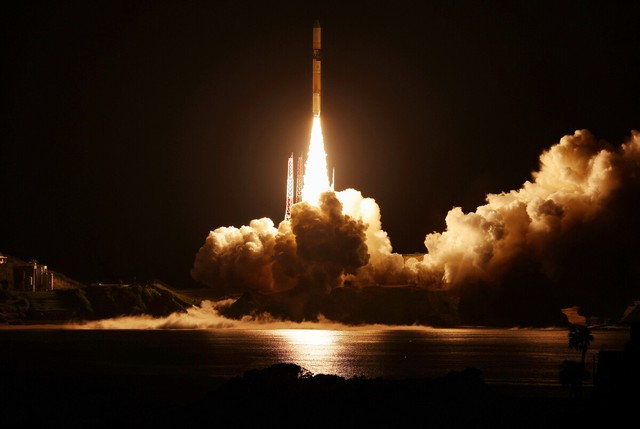
Japan successfully launches final H-2A rocket
Tanegashima, Kagoshima Pref. -- Japan's Mitsubishi Heavy Industries Ltd. successfully launched the last H-2A rocket from the Tanegashima Space Center in the southwestern prefecture of Kagoshima in the small hours of Sunday.

The 50th H-2A rocket carrying the GOSAT-GW greenhouse gas and water cycle observation satellite, nicknamed Ibuki GW, is launched from the Tanegashima Space Center in Japan's Kagoshima Prefecture in the small hours of Sunday. Photo: Jiji Press
The 50th unit of the H-2A rocket lifted off at 1:33 am and put the GOSAT-GW greenhouse gas and water cycle observation satellite, nicknamed Ibuki GW, into the planned orbit about 16 minutes later.
The launch marked the conclusion of the H-2A program, which supported Japan's space development for 24 years.
The H-2A series, which achieved a success rate of 49 out of the 50 launches, will be retired and fully replaced by the H3 series.
"We hope to carry out H3 launches, taking over the trust that has been built up" through the H-2A series, Iwao Igarashi, head of Mitsubishi Heavy's Space Systems Division, told a press conference.
The two-stage, liquid-fuel H-2A rocket was developed by the National Space Development Agency of Japan, now called the Japan Aerospace Exploration Agency, or JAXA.
The first H-2A unit was launched in 2001.
The production and launch operations for the H-2A series were transferred to Mitsubishi Heavy from the 13th unit launched in 2007, marking the rocket's entry into the commercial space market.
The only launch failure occurred with the sixth unit in 2003.
Despite the strong reliability, the high cost of 10 billion yen per satellite posed a problem as competition in the satellite launch market intensified with the emergence of U.S. companies like Space Exploration Technologies Corp., or SpaceX.
This led Japan to shift to the H3 series, whose costs have been reduced through the use of many commercial products as rocket components.
The Ibuki GW satellite, developed mainly by JAXA and the Environment Ministry, is equipped with sensors to observe greenhouse gases, such as carbon dioxide, and global water circulation, including precipitation and sea surface temperature.
The satellite will collect data to support efforts to reduce greenhouse gases and improve climate change forecasts.
After separation from the rocket, the satellite deployed its solar panels, and it is reported to be in normal condition.
It will spend about three months deploying an observation antenna and check its functioning.
The H-2A series launched four Himawari weather satellites and five Michibiki satellites to support the Japanese version of GPS.
As space probes and astronomical satellites increased in size, H-2A rockets sent into space the lunar orbiter Kaguya and the Hayabusa2 explorer, which brought samples back to Earth from the asteroid Ryugu.
Last year, the H-2A contributed to Japan's first soft landing on the moon in the Smart Lander for Investigating Moon (SLIM) mission.
On the Kagoshima island of Tanegashima, about 1,300 people gathered in a park in the town of Minamitane about 7 kilometers from the space center before dawn Sunday, hoping to see off the final H-2A rocket.
The crowd, which the town said was largest on record since 2017, watched as the rocket flew into the night sky with a roaring sound.
The whole area was filled with applause, and voices such as 'Bon voyage' and 'Thank you' were heard.
Shuri Kimura, 33, a planetarium worker from Saga Prefecture, was filming the launch in the front row of the crowd.
Kimura said the first rocket liftoff he saw on Tanegashima was an H-2A launch, adding that "I still remember the excitement I felt at that time."
Kimura plans to show the footage at his workplace.
Jiji Press
Link nội dung: https://news.tuoitre.vn/japan-successfully-launches-final-h-2a-rocket-103250630154957537.htm
